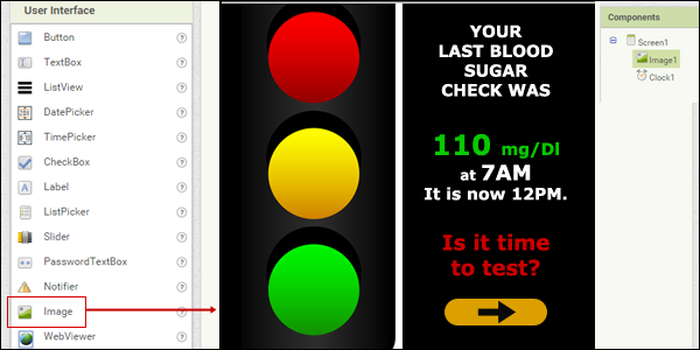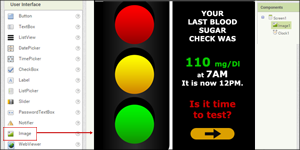Computer Programming for Better Health
Tools like AppInventor encourage students to explore computer programming by creating simple, functional apps. With improved healthcare management in mind, students are challenged to design an app that can help a patient or caregiver. By designing tools that can be immediately useful on a personal level, students can really see the power of using code to design their own apps. Using diabetes as an example, explore the ways students might program a helpful application.

When it comes to introducing students to computer programming logic, one of the most important empowering things for a student to realize is that you don't have to create a full-fledged, multi-stage, program to make something that can be immediately useful (or fun). Using accessible, drag-and-drop, block-oriented programming tools and environments like Scratch or AppInventor (both from MIT), a student can envision, design, and quickly create a functional app. When that app is one that fills a need or has the power to improve health management, the potential of programming and exploring code may really click for students as they make real-world connections between programming and designing tools that can make life better for themselves, friends, or family members.
Science Buddies has many projects that help introduce students to computer programming basics using the drag-and-drop code environment in Scratch, including a series of projects using Scratch on Raspberry Pi. Expanding on what a student can do with Scratch's block-oriented programming, Science Buddies has two projects that guide students in building an Android application using AppInventor: Can You Crowdsource a Better School Environment? and Building Personal Medicine Apps to Help Patients.
Health Connections
Following the Building Personal Medicine Apps to Help Patients project, students design and program a reminder application to help someone remember to take medications on time. This sounds like a very basic application, and it is. But this kind of simple app can be a very helpful and powerful tool for someone. Many variations on the core idea of a medicine reminder app are possible. What do you need to be reminded of and when? Do you use or wear a medical device that needs to be changed or restarted after a set number of hours or days? Do you often forget to do something related to your health that you need to do at a certain time each day?
Creating an "alert" or "reminder" app is a great way for students to start working with AppInventor and to begin exploring computer programming logic. As students begin working with and browsing the available blocks in the AppInventor programming environment, new ideas for apps that might be personally useful may emerge, and testing out those ideas by building simple programs is something students can do!
Making Connections with Diabetes
Someone managing Type 1 Diabetes has a large number of things to remember to do and keep up with each day, including: test blood sugar in the morning and before bed, test blood sugar every time before eating, take insulin before eating and when blood sugar is high, change lancets in the lancing device, change insulin infusion sites (if using an insulin pump), fill and change insulin cartridge (if using an insulin pump), change continuous glucose monitor (if wearing a CGM), restart continuous glucose monitor, calibrate continuous glucose monitor, charge insulin pump (if using an insulin pump), charge continuous glucose monitor receiver, switch bottles of insulin after a specific number of days, and call in refills. Each of these tasks is on a different time schedule, and many of them vary from person to person or device to device. With so many things to remember and keep track of, it can be easy for a person with diabetes (or a caregiver) to forget which day she last changed a pump site, for example, and remembering a detail like that is important because wearing a site too long can lead to problems.
In the context of a health condition like diabetes, different kinds of reminder or alert systems might make it easier to stay on top of important health-related tasks. Using AppInventor, what kind of alert system could you develop to make managing routine tasks easier?
Coding for a Cause
Programmers and developers are constantly working on new tools, apps, and web-based solutions that can help make managing diabetes easier. From tracking blood glucose readings, insulin, and carbohydrates to monitoring someone's blood sugar remotely or even from a smart watch to setting up closed loop systems in which multiple devices are able to talk to one another to improve insulin therapy, there are many, many exciting ways that computer programming is being used to improve life with (and management of) diabetes.
With their own personal motivation, students can begin programming and learning how to create applications and tools that can make a difference. AppInventor and Scratch both offer ways to get started with programming. Students can also explore by working through Hour of Code tutorials, using Cloud Pebble (for smartwatch programming), or by learning a specific coding language like .php, Python, C, etc. In many cases, open source repositories are available that enable students to begin making changes to existing code. Making small changes and seeing the effects of those changes is a great way to learn, hands-on, by doing.
No matter how they start or what language or coding environment they use, experimenting with computer programming as a hobby or as part of a science, technology, engineering, or math (STEM) project can be empowering and can spark a lifelong interest or career path.
For more information about student computer programming and Science Buddies computer science projects, see the following:
- Drag-and-drop Code: Engaging Students with Computer Programming
- Arduino Science Projects
- Diabetes Science Projects - Fostering Diabetes Awareness
- Drag-and-drop Code: Engaging Students with Computer Programming
- Biomedical Engineering: The Search for Solutions, Big and Small, for Type 1 Diabetes
- Computer Programming Basics: An Hour of Code
- Playful Programming and Cool Code: From Tech User to Tech Creator
To view more projects related to diabetes, see the Diabetes Science Project Ideas project area.
Categories:
You Might Also Enjoy These Related Posts:
- Plastics and Earth Day - Science Projects
- Arduino Science Projects and Physical Computing
- 10+ Robotics Projects with the BlueBot Kit
- 5 STEM Activities with Marshmallow Peeps
- March Madness Basketball Science Projects: Sports Science Experiments
- Women in STEM! More than 60 Scientists and Engineers for Women's History Month
- Explore Artificial Intelligence and Machine Learning with Student AI Projects
- 10 Reasons to Do the Rubber Band Car Engineering Challenge










